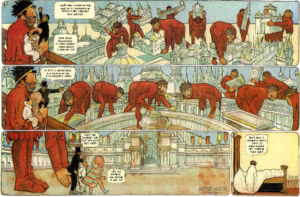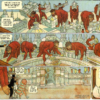Tânia A. Cardoso in V!RUS (2016). 
This article examines the highly influential comic Little Nemo in Slumberland (1905-1927), and how it represented the modern industrial city. The modern era, of revolutionary and progressist nature, was a great catalyst, not only at an industrial level, but in terms of communication and rupture of past paradigms. In this period the representation of the city was particularly intense: studies and ambitious projects emerged as reformers of issues associated with urban problems of that time. It is also at this moment that comics gain importance and prominence in society and especially in the city. The representation of the city gains a new dimension; it becomes an element of inspiration. The article explores to what extent the creator Windsor McCay was himself a radical modern in questioning the zeitgeist and the development of modern cities through Little Nemo in Slumberland?
